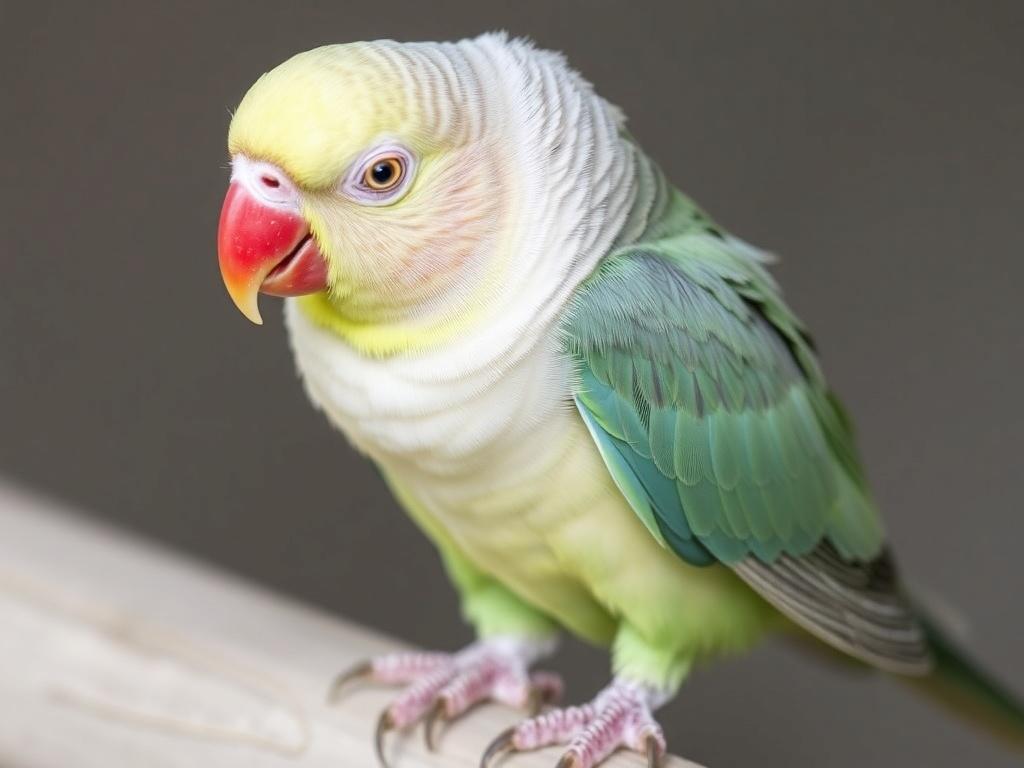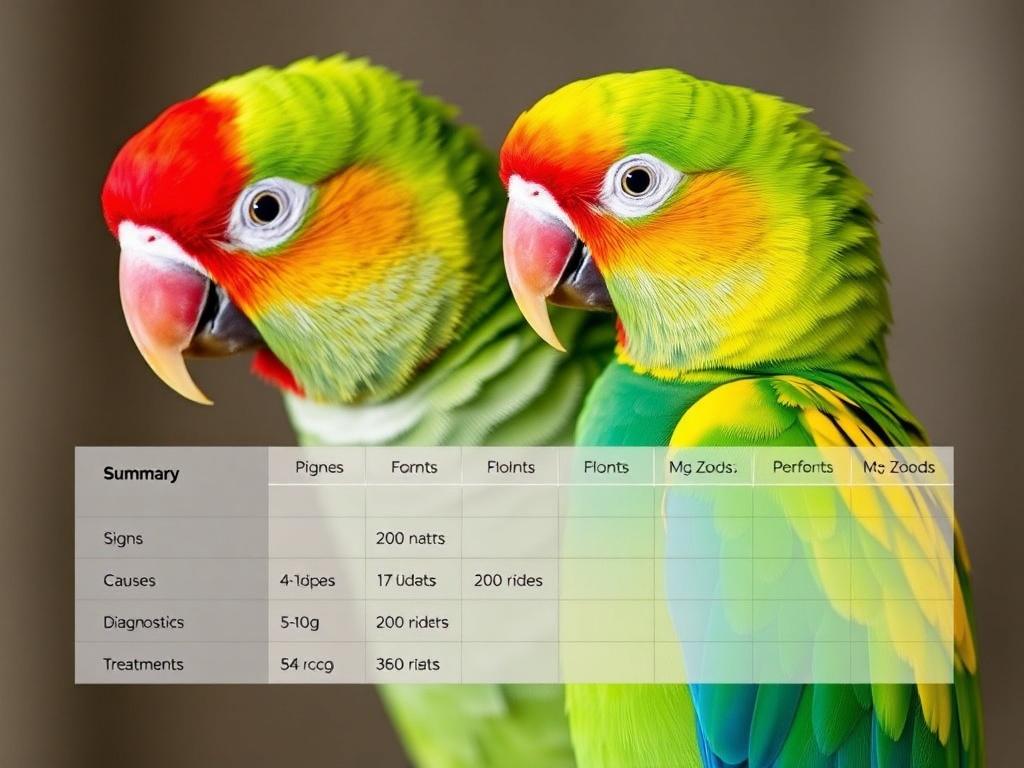Содержание
- What Is Gout in Parrots?
- Why Parrots Get Gout: Common Causes and Risk Factors
- Signs and Symptoms: What to Watch For
- How Vets Diagnose Gout in Parrots
- Treatment Approaches: Immediate and Long-Term
- Prevention: Practical Steps for Caregivers
- Foods, Supplements, and Items to Watch: A Table for Quick Reference
- Practical Home Care When Your Parrot Has Gout
- Medications and Their Use — What You Need to Know
- When Is Surgery or Procedural Intervention Considered?
- Living Long Term with a Parrot Diagnosed with Gout
- Questions Your Vet Will Likely Ask
- Case Examples: How Gout Can Present and Be Managed
- Common Misconceptions and Myths
- Red Flags: When to Get Emergency Care
- Resources and Support
- Summary Table: Signs, Causes, Diagnostics, and Treatments at a Glance
- Final Thoughts Before You Act
- Conclusion
SQLITE NOT INSTALLED
Gout is a word most of us associate with humans — grandfathers who wince when they stand, or classical paintings of swollen, painful feet. But gout is not just a human problem. Parrots and other birds can suffer from the same underlying issue: excess uric acid that crystalizes and damages tissues. If you love parrots, the thought of them sitting quietly but painfully with swollen joints or hidden organ disease is heartbreaking. The good news is that with knowledge, careful husbandry, and prompt veterinary care, many parrots with gout can be helped or their condition managed. This article takes you through what gout looks like in parrots, why it happens, how vets diagnose it, treatment and long-term care strategies, and what you as a caregiver can do to reduce the risk.
Parrots are charismatic, intelligent birds with unique physiology. Their excretion is based on uric acid rather than urea like mammals, so their kidneys and metabolic balance are tuned differently. That’s part of why gout in birds has features distinct from mammalian gout: it often shows up as visceral gout (chalky white deposits on internal organs) or articular gout (painful crystals in or around joints), and it can be a sign of serious kidney trouble. Read on — understanding the signs early and the common causes will help you get your bird the care it needs and reduce the chance of a painful progression.
What Is Gout in Parrots?
Gout in parrots is the result of hyperuricemia — elevated levels of uric acid or urate in the bloodstream — leading to deposition of urate crystals in tissues. Uric acid is the main nitrogenous waste product in birds, so their normal levels are naturally much higher than in mammals. Gout becomes a problem when the balance between uric acid production and elimination is disturbed, causing crystals to form and collect in joints, soft tissues, and on organs. Those crystals provoke inflammation and pain, and when internal organs are affected (visceral gout), the condition can be life-threatening.
There are two major forms of gout in birds:
- Articular (joint-related) gout: urate crystals collect in and around joints, causing swelling, pain, and lameness.
- Visceral gout: urate crystals deposit on the surface of internal organs like the liver, heart, kidneys, and air sacs; this is often only discovered at advanced stages or on necropsy.
Both forms can overlap, and both are a signal that something systemic — often kidney dysfunction, dehydration, or a metabolic problem — needs to be addressed.
Why Parrots Get Gout: Common Causes and Risk Factors
Understanding why gout develops in parrots helps you prevent and spot it early. There’s rarely a single cause — usually it’s a combination of underlying disease, diet, and environment that tips the balance.
Kidney disease and impaired excretion
The kidneys are the workhorses that remove uric acid in birds. Anything that reduces kidney function — chronic kidney disease, acute kidney injury from toxins or infections, or even age-related decline — will decrease uric acid elimination and raise blood uric acid. Kidney disease is one of the most common triggers for gout.
Dehydration and reduced urine flow
Birds concentrate uric acid in a semi-solid form. Dehydration reduces urine flow and the kidneys’ ability to flush urates, making crystal deposition more likely. Even short periods of poor water intake combined with illness can be dangerous.
Dietary factors
High protein intake increases the amount of nitrogenous waste the bird must handle. While parrots need adequate protein, sudden excessive protein, inappropriate supplements, or unbalanced diets (very high in certain amino acids) can increase uric acid production. Some treats, unregulated supplements, or “DIY” diets without veterinary oversight can contribute.
Toxins and medications
Certain toxins (heavy metals like lead or toxins that damage renal tissue) and some medications (aminoglycoside antibiotics, certain nonsteroidal anti-inflammatories, or nephrotoxic compounds) can injure the kidneys and precipitate gout. Always consult an avian vet before giving medications or supplements.
Metabolic and endocrine issues
Underlying illnesses like severe infections, dehydration from gastrointestinal disease, or metabolic disorders can alter uric acid balance. Stress and prolonged illness may also be contributing factors.
Signs and Symptoms: What to Watch For

Parrots are expert at hiding illness, so early gout may be subtle. Pay attention to changes in behavior, eating, mobility, and droppings. Here are the typical signs:
- Lameness, reluctance to stand, or favoring a leg or foot
- Swelling around joints (ankles, knees, toes, wing folds) or heat and pain when touched
- Reduced activity, less vocalization, sleeping more
- Decreased appetite or weight loss
- Visible chalky white deposits in advanced articular cases (rare in live birds) or decreased feather condition
- Changes in droppings — decreased moisture, or other signs of systemic illness
- Signs of visceral involvement: respiratory distress, lethargy, poor appetite, sudden death (in severe cases)
Because many of these signs are nonspecific, any persistent change should prompt a veterinary visit.
How Vets Diagnose Gout in Parrots
69939302fdf184a54e0c95cd66a8e57b.jpg
Veterinary diagnosis combines clinical signs, physical examination, and targeted tests. Early diagnosis improves the chances of effective treatment.
Physical exam
An avian vet will palpate joints, look for swelling, check hydration, examine the cloaca and droppings, and listen to the respiratory and cardiovascular systems. The exam helps localize pain and assess overall condition.
Bloodwork and chemistry
A blood chemistry panel can show elevated uric acid (sometimes called plasma urate), changes in kidney values, electrolyte imbalances, and signs of infection or inflammation. A complete blood count (CBC) helps identify infection or chronic disease.
Radiographs (X-rays)
X-rays can reveal joint effusion, soft tissue densities consistent with urate deposition, and underlying bone changes. They are also useful to evaluate the kidneys and coelomic cavity for visceral gout signs (though early visceral gout can be hard to see radiographically).
Imaging and ultrasound
Ultrasound may identify urate deposits on organ surfaces or within joints and can be helpful for sampling fluid from joints or coelomic effusion.
Joint aspiration and cytology
If a joint is swollen, a vet may aspirate fluid for microscopic examination. Urate crystals are often visible under the microscope and can help confirm articular gout. Cultures may also be done to rule out infection.
Post-mortem diagnosis
Unfortunately, visceral gout is sometimes only clearly identified at necropsy, where white chalky deposits on organ surfaces are visible. That’s why early vet evaluation for even subtle signs is so important.
Treatment Approaches: Immediate and Long-Term
Gout treatment aims to relieve pain, reduce uric acid levels and inflammation, correct underlying causes, and restore hydration and kidney function. Treatment must be tailored to the individual bird and guided by an avian veterinarian.
Emergency priorities
If a bird is reluctant to stand, very lethargic, or showing rapid breathing, immediate veterinary attention is required. Emergency care often includes:
- Stabilization with fluids (subcutaneous or intravenous) to correct dehydration and support kidney function
- Pain control and anti-inflammatory therapy as appropriate
- Diagnostic testing to find the cause
Early fluid therapy is often the most important first-line intervention because improving urine flow allows the kidneys to clear urates.
Medications and pharmacologic management
Veterinarians may prescribe:
- Fluid therapy (oral, subcutaneous, or intravenous) to rehydrate and promote urate excretion
- Anti-inflammatory medications for pain relief, chosen for safety in birds
- Antibiotics if infection is suspected
- Renal-supportive treatments depending on blood chemistry
- In some cases, drugs that alter uric acid metabolism have been used (xanthine oxidase inhibitors) under close veterinary supervision
Note: Not all human gout drugs are safe or effective in birds. Never give human medications without veterinary approval — avian dosing and drug tolerances differ widely.
Dietary and supportive care changes
Dietary adjustments often form a big part of treatment and prevention:
- Ensure clean, fresh water is always available; encourage drinking
- Feed a balanced, veterinarian-approved diet appropriate for the species with controlled protein levels
- Avoid high-protein treats and unregulated supplements that could overload the bird’s metabolic capacity
- Provide warm, stress-free housing and padded perches to reduce joint pressure and protect painful feet
Chronic management and monitoring
Some birds recover fully with treatment; others may have chronic kidney disease and require ongoing management:
- Regular check-ups with bloodwork to monitor uric acid and kidney values
- Diet adjustment and weight management
- Environmental changes to reduce stress and protect limbs — softer perches, low cage floors, non-slip surfaces
- Pain management and intermittent supportive fluids as recommended by your vet
Prevention: Practical Steps for Caregivers
Prevention is always better than cure. You can reduce your parrot’s risk of gout by paying attention to diet, hydration, environment, and routine health care.
Offer balanced nutrition
Commercially formulated pelleted diets designed for your parrot species provide balanced nutrition with predictable protein content. Use these as the core of the diet and offer fresh vegetables and limited fruits. Avoid excessive seeds and nuts as the primary diet; these tend to be high in fat and can be protein-dense depending on type.
Encourage regular water intake
Clean, fresh water should be available at all times. Some birds prefer water in bottles; others in shallow bowls. Offer water in both places if needed and change it daily. During illness or hot weather, watch for decreased drinking and consult your vet.
Avoid nephrotoxic exposures
Keep household toxins away — certain heavy metals, some household cleaners, and accidental ingestion of toxins can damage kidneys. Don’t give medications or supplements without avian veterinary approval.
Maintain routine veterinary care
Regular wellness exams catch early signs of kidney disease or metabolic problems. Baseline bloodwork as your bird ages can establish normal ranges for that individual and make early detection easier.
Keep stress low and the environment safe
Chronic stress can exacerbate illness. Provide mental stimulation, regular social interaction, consistent light-dark cycles, and safe, comfortable perching. Avoid sudden changes to diet and environment when possible.
Foods, Supplements, and Items to Watch: A Table for Quick Reference
| Category | Examples | Notes |
|---|---|---|
| High-risk foods | Large amounts of seeds and nuts, certain legumes if raw and in excess | Can be high in protein and fats; limit as treats, not staple |
| Good staples | Species-appropriate pelleted diet, a variety of vegetables | Balanced nutrition with controlled protein |
| Supplements | Multivitamins, protein powders | Use only under vet direction — unregulated supplements can be harmful |
| Potentially nephrotoxic items | Lead, zinc, certain human medications, some essential oils | Keep away from birds; consult vet before exposure |
Practical Home Care When Your Parrot Has Gout
If your vet confirms gout and gives a care plan, here are practical, gentle ways to support your parrot at home between vet visits.
- Follow fluid therapy instructions: your vet may ask you to give subcutaneous fluids at home — learn the technique from them and don’t guess at doses.
- Protect sore feet and joints: replace hard perches with softer, varied-diameter perches and add padded resting areas so your bird can sit comfortably.
- Keep the bird warm and quiet: avoid drafts and noisy disruptions during recovery.
- Provide easy access to food and water: move bowls to a low, stable surface; consider offering moistened pellets or soft foods if eating is difficult.
- Observe and record changes: note appetite, droppings, vocalization, and mobility — share this with your vet for better adjustments to treatment.
Medications and Their Use — What You Need to Know
Medication is often part of gout management, but several caveats apply.
Pain control and anti-inflammatories
Birds can benefit from carefully chosen pain control. Some NSAIDs or other analgesics are used by avian vets with specific dosing regimens. Don’t give human medications on your own; doses differ and some drugs are toxic to birds.
Uric acid–lowering medications
Medications that lower uric acid production have been used in avian practice, but their use requires careful monitoring. Effects and safety profiles are not as well-studied in birds as in humans. Any such medication should only be used under the direct supervision of an avian veterinarian.
Antibiotics and other supportive drugs
If infection is suspected, antibiotics appropriate for the bird and the likely organism are used. Sometimes diuretics or drugs to manage electrolyte abnormalities are needed. All therapy requires blood monitoring and follow-up.
When Is Surgery or Procedural Intervention Considered?
Surgery is rarely a front-line treatment for gout itself. However, some procedural interventions may be indicated:
- Joint flushing or aspiration to remove painful effusion and allow diagnosis
- Removal of a localized mass if urate deposition creates a discrete block or abscess
- Procedures to treat underlying urinary obstructions if present
These are case-by-case decisions made by your avian veterinarian.
Living Long Term with a Parrot Diagnosed with Gout
A chronic gout diagnosis can feel overwhelming, but many parrot owners adapt and provide high-quality lives for their birds.
Set up a comfort-focused environment
Soft perches, easy-to-access food and water, and quiet resting spots are critical. Reduce need for flight if that injures joints or causes pain.
Schedule regular wellness checks
Frequent monitoring with blood tests helps adjust treatment before crises occur. Work with your vet to find a schedule that balances thorough monitoring and reduced stress to the bird.
Nutrition as ongoing therapy
Consistency in diet is therapeutic. A vet-guided feeding program that supplies necessary proteins without overload is a foundation for long-term stability. Consider a nutrition consult with an avian specialist.
Quality of life decisions
If quality of life becomes poor despite best efforts, difficult decisions may arise. Having open conversations with your veterinarian early about prognosis and possible outcomes will make these times easier.
Questions Your Vet Will Likely Ask
When you see an avian vet, be prepared to answer questions that will help pinpoint the cause and treatment plan:
- When did you first notice symptoms, and what changed?
- What is the bird’s typical diet? Any recent diet changes or new supplements?
- Has the bird been exposed to any toxins or new household chemicals?
- Has the bird been on any medications recently?
- Are there changes in droppings, drinking, or behavior?
- Has the bird had prior episodes or chronic health problems?
These details help the vet prioritize testing and therapy.
Case Examples: How Gout Can Present and Be Managed
Here are illustrative, anonymized scenarios common in practice that show different faces of gout.
Case 1: The sudden-onset articular gout
A middle-aged African grey wakes one morning favoring one leg, reluctant to perch, with swelling around the hock. The owner brings the bird in the same day. Radiographs and joint aspiration show urate crystals. The bird receives fluids, appropriate pain relief, and dietary adjustment with veterinary follow-up shows rapid improvement over days to weeks.
Case 2: Chronic kidney disease with visceral gout
An older cockatiel has progressive weight loss and decreased activity. Routine bloodwork reveals elevated uric acid and kidney markers. Ultrasound suggests visceral urate deposition. Treatment focuses on long-term hydration support, dietary management, and palliative care. Quality-of-life monitoring becomes the central plan.
Case 3: Toxin-induced acute gout
A parrot exposed inadvertently to a nephrotoxic substance becomes dehydrated and acutely ill. Rapid veterinary intervention with fluids and supportive care can sometimes reverse early damage, but outcomes depend on the severity and timeliness of treatment.
These examples show the range of presentations and the importance of early veterinary assessment.
Common Misconceptions and Myths
Let’s clear up a few misunderstandings that can lead to delayed care.
- Myth: “Only old birds get gout.” Reality: While age-related kidney disease can increase risk, young birds can develop gout from acute kidney injury, dehydration, or toxins.
- Myth: “If a bird can still climb, it can’t be in pain.” Reality: Birds mask pain well; they may continue to climb or eat despite significant discomfort.
- Myth: “Home remedies for human gout will work.” Reality: Human gout medications and remedies are not directly transferable — they can be ineffective or dangerous for birds.
Red Flags: When to Get Emergency Care
Seek immediate veterinary attention if your parrot shows:
- Sudden severe lethargy, collapse, or inability to stand
- Marked breathing difficulty or open-mouth breathing
- Refusal to eat for more than a day or two, especially with other symptoms
- Rapidly worsening limb swelling with signs of severe pain
Time-sensitive care can make a major difference in outcome.
Resources and Support
Building a support network helps owners cope. Consider:
- Finding an avian veterinarian experienced with parrots — an online directory from a veterinary association is a good start
- Joining avian owner groups (with caution) to learn from others’ experiences — but always verify medical advice with a vet
- Keeping a health journal for your bird with weights, diet changes, and behavior notes to share at vet visits
Summary Table: Signs, Causes, Diagnostics, and Treatments at a Glance

| Topic | Key Points |
|---|---|
| Signs | Lameness, joint swelling, decreased appetite, lethargy, respiratory signs (visceral), changes in droppings |
| Common causes | Kidney disease, dehydration, high protein intake, toxins, medications, infection |
| Diagnostics | Physical exam, blood chemistries (uric acid), radiographs, ultrasound, joint aspiration |
| Treatment | Fluids, pain control, diet modification, treat underlying cause, possible uric acid-lowering drugs under vet care |
| Prevention | Balanced diet, fresh water, avoid toxins, routine vet care, stress reduction |
Final Thoughts Before You Act
If you suspect gout in your parrot, the single best thing you can do is contact an avian veterinarian promptly. Because the condition often signals kidney or metabolic problems, delaying diagnosis can worsen outcomes. At home, ensure the bird has fresh water, limit stress, and avoid giving medications without vet approval. With quick action and good veterinary guidance, many birds can recover or be managed effectively to enjoy comfortable lives.
Conclusion
Gout in parrots is a serious, often painful condition tied to the bird’s balance of uric acid, kidney health, diet, hydration, and environmental exposures; recognizing subtle signs, seeking prompt veterinary care, and making long-term adjustments in diet and husbandry can greatly improve outcomes and quality of life for affected birds.





